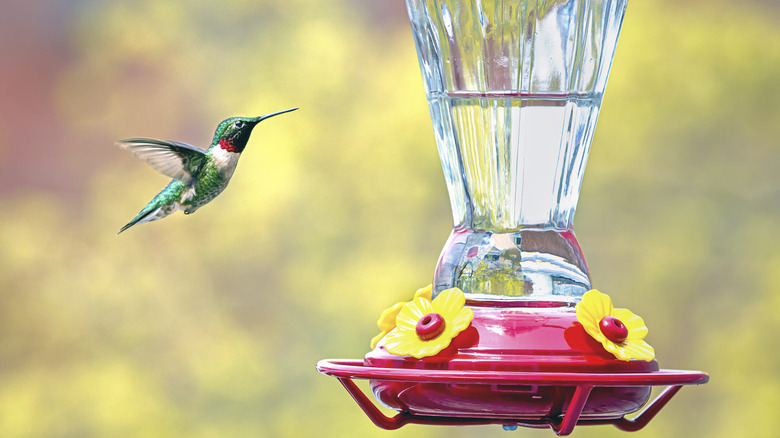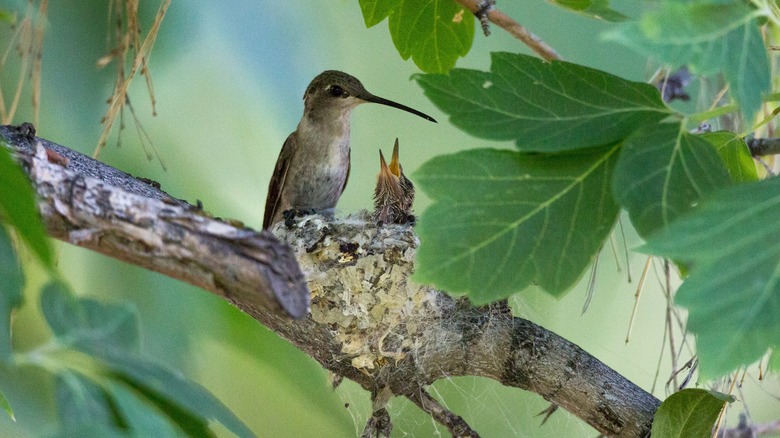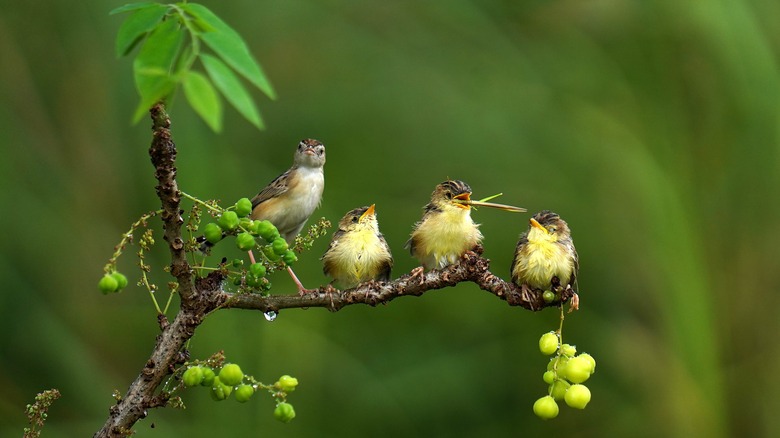What Baby Hummingbirds Eat & When You Can Expect To See Them At Your Feeder
Hummingbirds are one of nature's little miracles. The United States is home to 15 unique species with nine others that visit from other regions. With so many flitting about, it's no surprise these tiny, colorful creatures frequent gardens across the country. Most measure 3 to 5 inches when fully grown, and weigh less than a dime as new hatchlings. This garners excitement about how soon it might be before babies get a turn to visit your garden and what they eat. Feeders hung on trees and patios provide adult birds with a sugar water treat, but our feathered friends need more than sweet water alone. They also require protein, usually in the form of insects.
Knowing new chicks are so small, about 1 inch in size, it's unlikely they're bounding around catching bugs. In fact, they're born with very tiny, weak feet, and nestlings are unable to stand. This leaves mama bird in charge of delivering nutrients to her chicks. So, what is it she gives them? Check out what baby hummingbirds consume in a day, and when you can expect them to arrive at your feeders.
The average diet of a baby hummingbird
There's a reason why baby hummingbirds are so hard to spot. Before they ever make their way to sugar water feeders, they need to strengthen their bones, wings, and beaks. Being too weak to stand or fly, they depend on their mothers for around a month and up to two months in some species. Like many chicks, nutrients arrive through parental regurgitation. In this case, it's a mix of insects and flower nectar. That may not sound too appetizing to humans, but it's the perfect blend of protein and carbohydrates for a hatchling. The babies require multiple daily feedings. In fact, according to the National Audubon Society, an American bird conservation non-profit, mothers hunt 200 times a day and feed their nestlings every 20 minutes.
The recipe for a perfectly balanced diet depends on the species, climate, and native flora. Food preferences also change based on body size and beak length. The Calliope Hummingbird (Selasphorus calliope), for example, prefers tube-shaped flowers the larger breeds can't reach and the Broad Tailed Hummingbird (Selasphorus platycercus) eats tree sap along with nectar. For protein the Ruby Throated Hummingbird (Archilochus colubris) snacks on mosquitos, gnats, spiders, and even small bees, while the Black-Chinned Hummingbird (Archilochus alexandri) feasts on wasps, beetles, ants, and spiders. Nestlings are fed the standard fare of their respective breeds. Luckily for bird lovers, they eventually get strong enough to leave the nest and look for their meals in your garden.
When hummingbird babies finally leave the nest
Most North American hummingbird breeds mate in the Spring months, although some species in warmer climates mate much earlier and for longer periods. The eggs hatch approximately two weeks later. While chicks remain dependent on mothers during the first month of life, they start stretching and preparing their wings for flight within two weeks of hatching. Most babies attempt a test flight before they are 30 days old. With a total wait time of about 45 days from egg to independence, many hatchlings will be ready to visit gardens across the U.S. while the older birds are in town.
Arrival depends entirely on breed, location, and climate consistency. The West Coast, Southwest, and Southeast usually have hummingbird visitors year-round. Those east of the Rockies see the common Ruby-Throated variety flocking in through the Gulf Coast in March and reaching northern regions by April and May. These migrators leave again at the end of the summer into September. Once a fully grown nestling has been to your feeder, you might actually be seeing the same hummingbirds in your yard every year. They tend to visit the same locations on their annual migrations. While you may never spot a chick in your garden, you can count on the arrival of newcomers within 45 days of birth. Who knows, your feeder may even be helpful to a mama bird feeding nestlings their favorite meal of insects and nectar.


